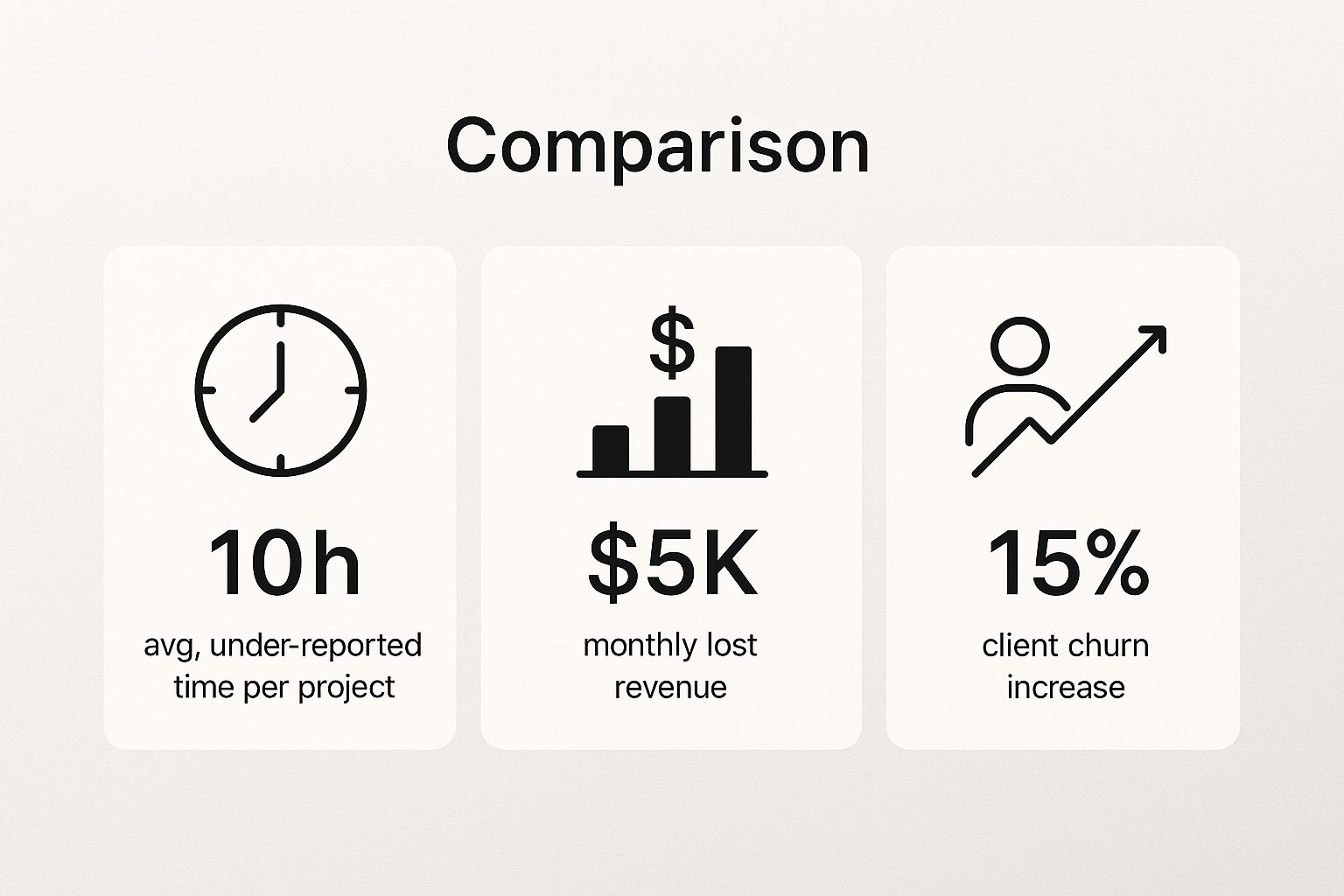Let's be honest, the phrase "time tracking" can make agency folks a little nervous. It brings up images of micromanagement and Big Brother watching over your shoulder. But what if we flipped that script?
Think of it less as a stopwatch and more as the financial bedrock of your agency. It’s the difference between guessing where your money is going and knowing. This practice is what allows smart agencies to nail down project costs, deploy their teams wisely, and build rock-solid client trust through total transparency.
Why Time Tracking Is an Agency Growth Engine
Let's clear the air right away: time tracking is not a tool for spying on your team. It’s your agency’s compass. Without it, you’re flying blind, making critical business decisions based on gut feelings and shaky assumptions. That’s a risky game that almost always leads to under-quoted projects, burnt-out teams, and razor-thin profit margins.
The simple truth is that accurate time data separates the agencies that thrive from those that just survive. It gives you the clarity to stop guessing and start making informed, strategic moves. When you know exactly where every billable hour is spent, you unlock a whole new level of understanding about your agency's health.
Master True Project Profitability
Basing a project quote on a hunch is a fast track to losing money. Time tracking pulls back the curtain, showing you the real-world effort that goes into every single deliverable, client, and service you offer.
Once you have that data, you can:
- Price with Confidence: Ditch the "finger in the air" quotes. You can now build proposals backed by hard data from past projects, ensuring you’re profitable from day one.
- Identify Hidden Costs: Finally see which clients or project types are secretly eating up way more resources than you thought. This allows you to renegotiate retainers or adjust your service packages accordingly.
- Protect Your Margins: Get a clear view of where scope creep is chipping away at your bottom line. Now you have the proof you need to have productive conversations with clients about work that goes beyond the original agreement.
This isn't just a nice-to-have anymore; it's a necessity. The global market for time tracking software hit a value of USD 5.23 billion in 2023 and is expected to balloon to USD 12.3 billion by 2030. That explosion shows a massive industry shift toward data-driven operations, especially for service businesses like agencies.
Optimize Resource Allocation
Your team's time is your single most precious—and limited—asset. Good time tracking acts like a real-time map of your team's capacity, helping you sidestep burnout while boosting everyone's output.
By understanding workload distribution, you can ensure the right people are on the right tasks without overloading your top performers. This visibility is key to maintaining a healthy, productive, and balanced team environment.
This data-driven approach is the foundation for more effective project management for creative teams. It gives you the power to accurately forecast future bandwidth, justify bringing on new hires, and make sure every project is staffed for success.
Ultimately, it all comes down to building a culture of transparency. When your invoices are backed by detailed time reports, client trust skyrockets. It puts an end to billing disputes and reinforces the value you provide, turning a simple admin task into a powerful engine for strategic growth.
The Hidden Costs of Inaccurate Time Data
The damage from bad time tracking goes way beyond a few missed billable hours. Think of inaccurate time data like a slow leak in your agency’s foundation. It might seem small at first, but over time it can cause serious, structural damage. It's the silent profit killer that chews away at your margins, burns out your team, and slowly torpedoes your biggest goals.
This isn't about micromanaging every single minute of the day. It’s about recognizing the painful domino effect that begins with one bad estimate. A project you underbid—based on fuzzy data from the last one—is almost guaranteed to suffer from scope creep. Next thing you know, your team is pulling late nights just to keep up, building resentment while your profit margin evaporates with every untracked task.
The Financial Black Hole of Underbidding
One of the most immediate and painful results of shaky time data is flawed project bidding. When you can’t say for sure how long a similar project actually took, your proposal is just a well-dressed guess. That guesswork usually leads to underquoting, a mistake that puts you on the defensive before a single deliverable is even started.
Here’s a scenario that plays out in agencies every single day:
- Project A (Last Quarter): A website redesign. The team feels like it took "around 200 hours," but nobody was tracking their time with any real discipline.
- Project B (Today): A new client asks for a quote on a nearly identical redesign. You build the proposal based on that "around 200 hours" figure.
- The Reality: Project A actually took 280 hours once you factor in all the unlogged client revisions and last-minute bug fixes. You just underbid the new project by 40%, guaranteeing it will lose money.
This cycle of underbidding creates a constant financial drain. You end up giving away work for free without ever knowing it, which puts a direct hit on your cash flow and long-term stability. A huge part of this hidden cost comes from miscalculating project expenses, making it vital to have accurate time data to properly estimate things like social media management costs and other service-based work.
Eroding Client Trust and Damaging Relationships
It's not just an internal problem; inaccurate time data actively harms your client relationships. When a client gets a vague invoice with big, round numbers and no real breakdown, it breeds suspicion. They have zero visibility into where their money is going, which often leads to invoice disputes, arguments over scope, and a general breakdown of trust.
Transparent billing, backed by detailed time reports, transforms invoicing from a potential conflict point into a trust-building exercise. It demonstrates professionalism and proves the value you deliver for every dollar spent.
Without that proof, you have no leverage when scope creep happens. When the client asks for "just one more small change," you have no data to show them how those "small" requests are adding up and blowing the budget. You’re forced to either eat the cost or have an awkward conversation with no evidence to back you up.
Strategic Blind Spots and Flawed Decision-Making
Maybe the most dangerous hidden cost is that it makes it impossible to make smart strategic decisions. Without accurate data, agency leaders are flying blind. You simply can't answer the most fundamental questions about your own business.
- Which of our services are actually profitable, and which ones are just eating up resources?
- Are our retainers priced correctly, or are we losing money on our best clients?
- Who on our team is most efficient at specific types of tasks?
- Can we realistically take on that massive new project next month?
Without solid time tracking for agencies, the answers to these questions are based on gut feelings, not facts. This leads to flawed planning, where you might double down on an unprofitable service or fail to recognize which clients are actually driving your growth. In the agency world, precision isn't a luxury—it's the only way to steer your ship toward sustainable growth and away from those costly, hidden icebergs.
Choosing the Right Time Tracking Tool for Your Agency
Picking the right time tracking tool for your agency can feel like you're lost in a sea of options. With hundreds of platforms all promising to fix your problems, it's easy to get overwhelmed. The trick is to look past the simple start-stop timers and zero in on the features that solve real agency headaches.
A generic checklist just won't do. Your agency has its own unique way of working, a specific set of tools you already rely on, and a distinct company culture. The right tool won't make you overhaul your entire process; it will slide right into your existing workflows, making life easier for your team and giving leadership the clarity it needs.
This is about finding a partner in profitability, not just another subscription. You're looking for a platform that genuinely gets the agency model—from client billing and project management to team capacity and resource planning. Let’s dive into the features that actually move the needle.
Prioritize Seamless Integrations
Your time tracking tool can't be a lone wolf. To be truly useful, it needs to connect effortlessly with the software your team lives in every day. This simple step gets rid of the friction of bouncing between apps and makes sure data flows smoothly across your entire tech stack.
Picture your project management tool, like Asana or Jira, automatically syncing tasks with your time tracker. When a designer logs hours on a creative brief, that time instantly shows up against the correct project budget and client account. That kind of connectivity is the bedrock of an efficient agency.
For any modern agency, these integrations are non-negotiable:
- Project Management: Tools like Asana, Trello, or Jira to link every minute of work directly to tasks and deliverables.
- Accounting Software: Platforms like QuickBooks or Xero to make invoicing and payroll a breeze.
- Communication Hubs: Apps like Slack that let your team make quick time entries or get notifications without leaving their main conversation.
- Calendars: Connections with Google Calendar or Outlook that can automatically log the time spent in meetings.
Without these connections, you're just trading one problem for another by creating more manual data entry. The goal is a unified system where information is shared automatically, slashing errors and saving countless admin hours.
Look for Agency-Specific Reporting and Analytics
Basic reports showing a list of hours logged are table stakes. A powerful time tracking for agencies tool delivers deep, actionable insights that help you make smarter business decisions. You need reporting that speaks your language.
This means you should be able to instantly see profitability breakdowns by client, project, or even by a specific service. Can you quickly spot which retainer is your cash cow? Or which type of project consistently bleeds the budget? These are the questions your software should answer without you having to dig for them.
The right tool transforms raw time data into a strategic asset. It should clearly visualize where your most valuable resource—your team's time—is generating the most return, allowing you to double down on what works.
The stats below really drive home what’s at stake when tracking is off, highlighting just how crucial precise reporting is.
This data shows how even small inaccuracies can snowball into major financial hits and unhappy clients. It’s a stark reminder that every unlogged hour directly impacts your agency's health and bottom line.
Features That Drive Adoption and Accuracy
Let's be honest: even the most powerful software is useless if your team refuses to use it. That's why you need to look for features designed to make time tracking less of a chore and more of an invisible, helpful part of the workday.
When you're evaluating different platforms, it’s not just about the big-picture analytics. The small, user-friendly details are what make or break team adoption. A tool that feels intuitive and helpful will always outperform one that feels like a burden. Below is a quick rundown of what to look for and why it matters for your agency.
Key Time Tracking Features for Agency Success
| Feature | Why It's Critical for Agencies | Top Tools Offering This |
|---|---|---|
| Automated Reminders | Gentle nudges to complete timesheets reduce forgotten entries and dramatically improve data accuracy without nagging. | Harvest, Toggl Track, Clockify |
| Mobile App | Allows team members to log time on the go—from client meetings to off-site shoots—capturing billable hours in the moment. | Toggl Track, TimeCamp, Everhour |
| Timer Integrations | Enables starting and stopping timers directly within project management tools (like Asana or Jira), eliminating app-switching. | Everhour, Harvest, Trello |
| Billable vs. Non-Billable | Clearly separates client work from internal tasks, giving you a precise view of team utilization and project profitability. | QuickBooks Time, Clockify, FreshBooks |
| Customizable Reports | Generates reports filtered by client, project, or task, turning raw data into actionable insights for strategic decisions. | TimeTackle, Harvest, ClickUp |
These features aren't just "nice-to-haves"—they're essential for building a time tracking habit that sticks. The easier you make it for your team to capture their time accurately, the more reliable your business data will be.
Ultimately, you’re searching for a platform that makes accurate time capture feel effortless. Before you pull the trigger, spend some time with guides that compare different options side-by-side. To get a head start, check out our guide on the top team time tracking software tools and see how the leading platforms stack up.
Implementing Time Tracking Without Team Pushback
Let’s be honest. The toughest part of bringing in a time tracking system isn’t the software—it’s the people. Teams often see it as a new way to micromanage or a sign that you don't trust them. If you want this to work, you have to flip the script from "monitoring" to "empowering."
Think of this less as a software launch and more as a shift in your agency's culture. The real goal is to introduce a system that earns buy-in by showing everyone how it protects their time, makes their work better, and ultimately makes the whole agency stronger. A little empathy and a smart approach can turn skepticism into genuine enthusiasm.
Communicate the Why with Transparency
The absolute first step is to be radically honest about your reasons for doing this. If you don't, your team will fill in the blanks with their own worst-case scenarios. Frame the entire conversation around shared goals and benefits that actually matter to them.
Keep your message clear, consistent, and focused on the positives.
- Protecting Team Capacity: Explain how accurate data is your best weapon against burnout. When you know how long projects actually take, you can push back on unreasonable deadlines and protect your team from getting buried in work.
- Fairer Workloads: Show how time data helps you see who's drowning and who has room to spare. It's about distributing work more evenly, not just piling it on the same few people.
- Justifying New Hires: Time tracking gives you the cold, hard data needed to make the case for more help. It proves when a team is stretched to its limit and needs backup.
- Smarter Project Scoping: Talk about how past data leads to way better project estimates. This is how you stop underquoting, which is the root cause of scope creep, late nights, and frantic fire drills.
When your team sees that this is about improving their work life, not just watching the clock, you’ll find they’re much more willing to get on board.
Involve Your Team in the Process
Never, ever spring a new tool on your team without their input. The single best way to build ownership and kill pushback before it starts is to give them a seat at the table. After all, they’re the ones who have to use this thing every single day.
Put together a small group with people from different departments. Let them test-drive a few tools you've shortlisted and get their real, unfiltered feedback. Ask them simple questions like, "Which one feels less like a chore?" or "Which of these actually fits into how you work?"
By making your team part of the decision, you shift their role from passive recipients to active participants. This simple act can transform their perception of the entire initiative.
Their involvement ensures you pick a tool people will actually use, not one that just collects digital dust. It also sends a clear message: you trust their judgment and value their experience.
Launch with a Pilot Program and Celebrate Wins
Whatever you do, don't try to roll this out to everyone at once. That's a recipe for chaos. Start small with a pilot group—ideally, a few enthusiastic folks who are open to new things. This gives you a safe space to find and fix any problems before going agency-wide.
Think of your pilot team as internal champions. They can work out the kinks, figure out best practices, and then share their positive experiences with everyone else. It creates a natural, positive buzz.
Once you’ve got some data coming in, use it to highlight wins. Did the design team knock out a project 15% under budget? Share that success! Did better data help you renegotiate a client’s retainer for more money? That's a win for the whole agency. To really get your team on board, you need to show them you’re committed to making the process motivating. For deeper insights, you can learn more about how to motivate employees to track time from our detailed guide.
By constantly pointing to the positive results—better planning, fairer workloads, and smarter growth—you build a culture where time tracking for agencies is seen for what it truly is: a tool for shared success, not a tool for scrutiny.
Turning Raw Time Data into Strategic Insights
So you've done the hard part—your team is actually tracking their time. Now what? All that raw data pouring into your system is a bit like unrefined oil; its real value is locked away until you start processing it.
This is the point where time tracking for agencies stops being an administrative chore and becomes a strategic superpower.
Just collecting hours isn't the endgame. The magic happens when you start digging into that data to answer the biggest questions your agency is facing. These are the insights that separate agencies that just react to problems from those that proactively build their future.
From Timesheets to Trendspotting
Your time tracking reports are a goldmine. Seriously. Instead of seeing them as just a record of what's already happened, think of them as a roadmap for where your agency should go next. Every report tells a story about your efficiency, profitability, and team capacity.
Start by digging into these key areas:
- Project Profitability Analysis: This is ground zero for any agency. Compare the hours logged against a project's budget or retainer, and you'll see in black and white which clients are your cash cows and which ones are slowly bleeding you dry.
- Team Utilization Rates: This report shows you how much of your team's time is spent on billable client work versus internal, non-billable tasks. It's the best tool you have for spotting burnout before it takes hold and making sure your team's time is spent where it counts.
- Service Line Performance: Are you losing money on social media but killing it on web development? This analysis helps you pinpoint which services are your winners and losers, guiding you on where to double down.
With this kind of clarity, you can finally move beyond guesswork. Decisions on pricing, hiring, and your service offerings are suddenly backed by cold, hard data—not just gut feelings.
Answering Your Biggest Business Questions
When you get good at data analysis, you can start tackling the high-stakes questions that really determine your agency's health. Think of your time tracking software as an in-house consultant that always has the evidence to back up its recommendations.
By transforming raw hours into clear financial and operational metrics, you empower your leadership team to make smarter, faster decisions. This is how you spot hidden inefficiencies and uncover new opportunities for growth.
Wondering if your retainers are priced correctly? A budget vs. actuals report will tell you instantly. Is a certain project team always behind? A task-level time report might show you exactly where the bottleneck is. The goal is to get into a rhythm of looking at this data regularly. A great first step is learning how to do a time audit to get a solid baseline of your agency's performance.
This disciplined approach is why the impact is so significant. The software helps you find wasted time, which naturally boosts accountability and better time management. In an agency where every hour can be billed, that's vital. This focus has been shown to reduce errors within organizations by about 50% while also improving payroll accuracy and the ability to hit deadlines.
Ultimately, your time data is the most honest reflection of how your agency operates. Learn to read it, and you gain the power to not just manage your agency, but to steer it toward greater profitability and a more sustainable future.
Common Questions About Agency Time Tracking
Even the most well-thought-out plan for time tracking for agencies is going to bump up against some real-world questions. It's totally normal to have concerns about how it will all work in practice, from team buy-in to the nuts and bolts of billing.
This is your quick-fire FAQ section. We'll tackle the most common questions agency leaders ask, giving you straight answers so you can get your system up and running with confidence.
How Do I Handle Team Members Who Forget to Track Time?
Ah, the classic problem. This is probably the biggest hurdle most agencies face, but it's completely solvable with the right mix of tech and process. The goal is to make time tracking so easy it just becomes part of the daily rhythm, not a dreaded chore saved for 4:59 PM on a Friday.
First off, your tool needs to do the heavy lifting. A platform that sends a friendly reminder through Slack or pops up a notification at the end of the day is a game-changer. It's far more effective than a manager having to chase down timesheets.
Here are a few practical steps you can take:
- Automate as Much as Humanly Possible: Look for tools that have calendar integrations to log meetings automatically or timers that live inside the project management apps your team already uses, like Asana or Trello. The less manual work, the higher the compliance.
- Set a Clear Standard: Make time tracking a non-negotiable part of the daily wind-down. A simple "nobody clocks out until their time is logged" rule can build a powerful habit across the entire team.
- Lead From the Front: When leadership and senior team members are diligent about tracking their own time, it sends a powerful signal: this is important, and we're all in it together.
It really all boils down to consistency. Make the process simple and the expectation clear, and you'll see compliance skyrocket.
Will Time Tracking Make My Team Feel Micromanaged?
This is a huge—and completely valid—concern. Nobody wants to feel like Big Brother is watching over their shoulder. The feeling of being micromanaged only creeps in when your team doesn't understand why you're tracking time in the first place. If they think it's about policing their every move, they'll naturally push back.
The trick is to frame time tracking as a tool for shared intelligence, not top-down scrutiny.
The narrative should always be about protecting the team's capacity, ensuring fair workloads, and making smarter business decisions that benefit everyone. It’s a tool to stop burnout, not to cause it.
Shift the conversation to outcomes that directly impact them for the better. Explain how this data will be used to:
- Justify hiring more help when you can clearly show a team is stretched thin.
- Price projects more accurately to avoid those frantic, under-scoped death marches.
- Spot and fix the operational bottlenecks that make their jobs harder.
When your team sees the data being used to make their work lives better, that fear of being watched melts away. It becomes a system that empowers them instead of policing them.
What Is the Best Way to Track Non-Billable Time?
Don't make the mistake of thinking non-billable time is less important. It's just as critical as your billable hours. This is the time spent on internal meetings, new business pitches, admin work, and training—all the stuff that keeps your agency running and growing. It gives you a true picture of your operational overhead.
The best way to handle this is by creating specific categories for non-billable work in your time tracking software. Don't just throw everything into one big "Internal" bucket and call it a day.
Get granular with categories like these:
- Internal Meetings: For all-hands, department check-ins, and one-on-ones.
- Business Development: Time spent writing proposals, creating pitches, and sales calls.
- Professional Development: Includes training, online courses, and attending conferences.
- Administrative Work: All the general agency upkeep that isn't tied to a specific client project.
By analyzing this data, you'll uncover the true cost of running your agency. For most healthy agencies, a good target is around 60% billable time, leaving the other 40% for all that essential non-billable work. If that ratio starts to get out of whack, you'll know exactly where your time is really going. This is a crucial piece of the puzzle for any agency that wants to scale profitably.
Ready to transform your agency's productivity and profitability with effortless, AI-powered time tracking? TimeTackle captures your team's work automatically from their calendars, eliminating timesheet headaches and delivering the strategic insights you need to grow. Start your free trial today and see the difference data can make.







